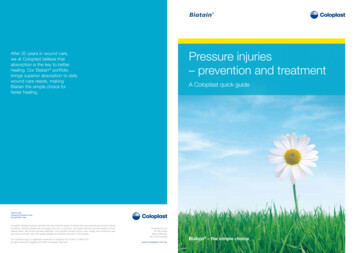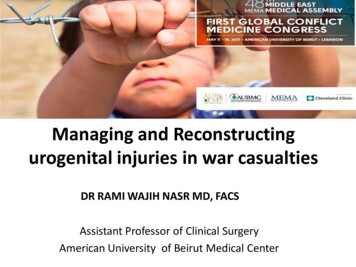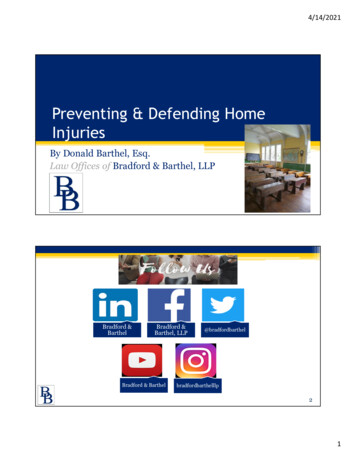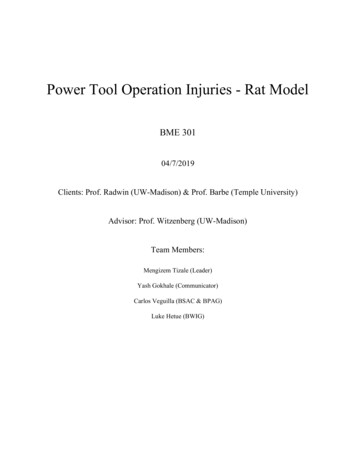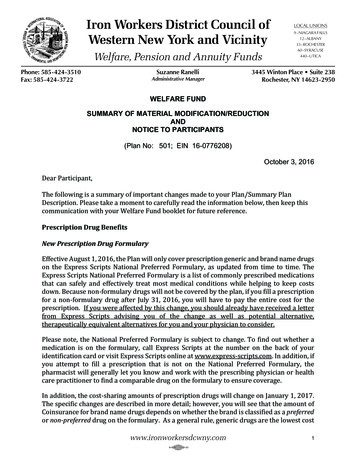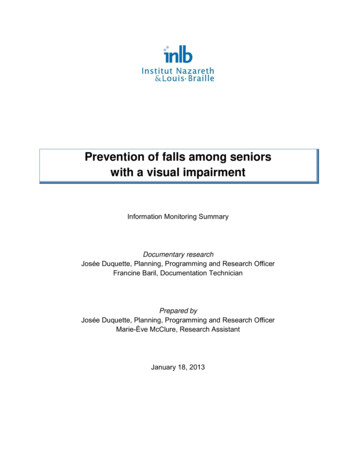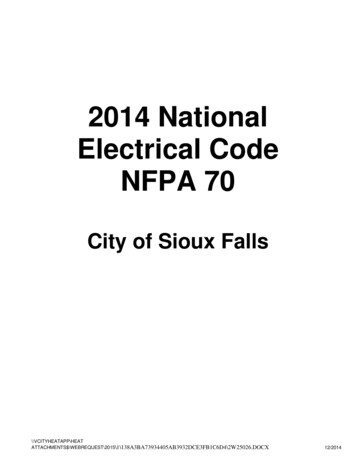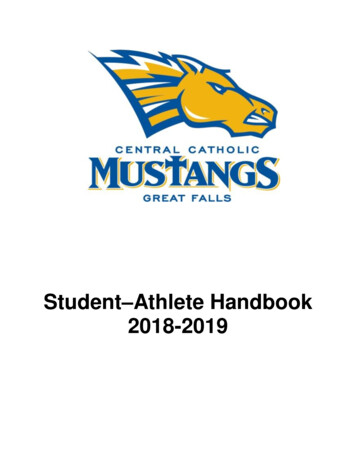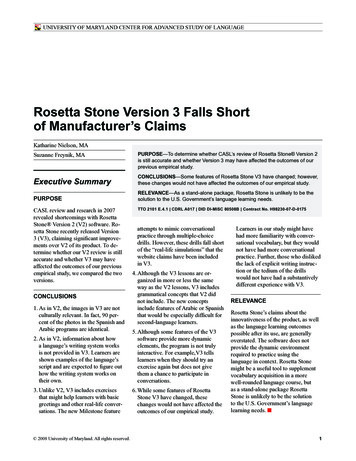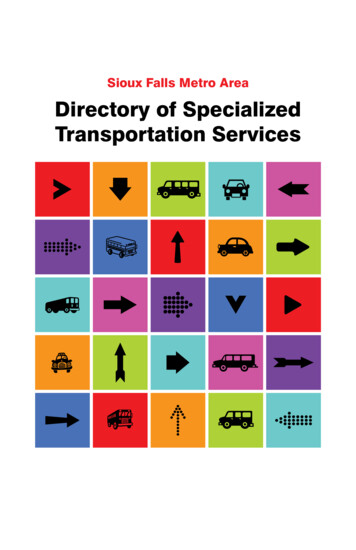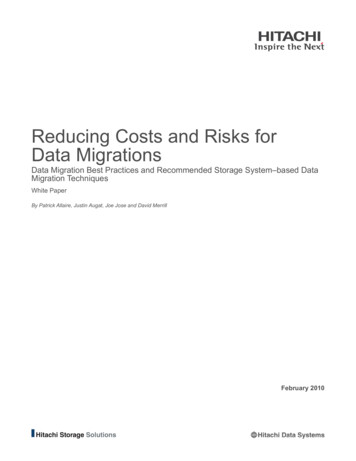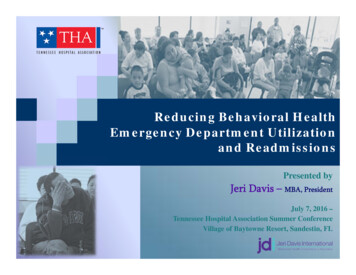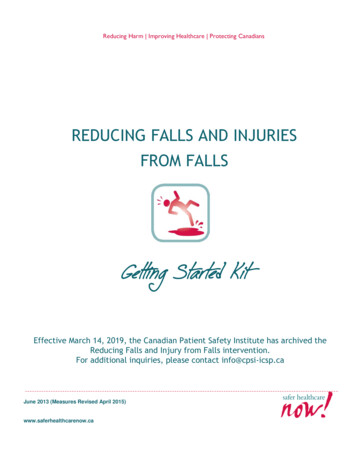
Transcription
Reducing Harm Improving Healthcare Protecting CanadiansREDUCING FALLS AND INJURIESFROM FALLSGetting Started KitE ffective March 14, 2019, the Canadian Patient Safety Institute has archived theReducing Falls and Injury from Falls intervention.For additional inquiries, please contact info@cpsi-icsp.caJune 2013 (Measures Revised April 2015)www.saferhealthcarenow.ca
Safer Healthcare Now!Reducing Falls and Injuries from Falls Getting Started KitSafer Healthcare Now!We invite you to join Safer Healthcare Now! to help improve the safety of the Canadianhealthcare system. Safer Healthcare Now! is a national program supporting Canadianhealthcare organizations to improve safety through the use of quality improvement methodsand the integration of evidence in practice.To learn more about this intervention, to find out how to join Safer Healthcare Now! And togain access to additional resources, contacts, and tools, visit our website atwww.saferhealthcarenow.caThis Getting Started Kit (GSK) has been written to help engage your interdisciplinary teams in adynamic approach for improving quality and safety while providing a basis for getting started.This Getting Started Kit represents the most current evidence, knowledge and practice, as ofthe date of publication and includes what has been learned since the first kit was released in2010. We remain open to working consultatively on updating the content, as more evidenceemerges, as together we make healthcare safer in Canada.Note:The Getting Started Kits for all interventions used by Safer Healthcare Now! are available inboth French and English.This document is in the public domain and may be used and reprinted without permissionprovided appropriate reference is made to Safer Healthcare Now!As of June 1, 2016, Safer Healthcare Now! is no longer collecting data and Patient Safety Metrics is no longer available.Our Central Measurement Team continues to offer expert measurement coaching and consultation.June 2013 (Measures Revised April 2015)Page 2
Safer Healthcare Now!Reducing Falls and Injuries from Falls Getting Started KitAcknowledgementsThe Fall Prevention/Injury Reduction Getting Started Kit has been adapted from the earlier2010 version of the Canadian publication: Preventing Falls and Injury from Falls GettingStarted Kit developed by Safer Healthcare Now! in partnership with the Registered Nurses’Association of Ontario.The Registered Nurses’ Association of Ontario (RNAO) is the professional associationrepresenting registered nurses in Ontario. The International Affairs and Best PracticeGuidelines Program (IABPG) is a signature program of the RNAO. Since 1999, with fundingfrom the Ontario Ministry of Health and Long-Term Care, IABPG has focused on thedevelopment, dissemination, implementation, evaluation and support for uptake of clinicaland healthy work environment best practice guidelines to support the development ofevidence-based practice cultures. One evidence-based resource developed early was theguideline Prevention of Falls and Injury from Falls in the Older Adult (rev. 2011). TheCanadian Patient Safety Institute, recognizing the contributions the RNAO had made in thearea of falls best practices, approached the RNAO to act as the Safer Healthcare Now! FallsPrevention Intervention Lead and work with the Canadian Patient Safety Institute FallsIntervention Faculty to update the Falls Prevention/Injury Reduction Getting Started Kit.The Registered Nurses’ Association of Ontario for preparing the Fall Prevention/Injury ReductionGetting Started KitThe Canadian Patient Safety Institute (CPSI) provided both financial and in-kind support towardthe development of the Safer Healthcare Now! Fall Prevention/Injury Reduction GettingStarted KitJune 2013 (Measures Revised April 2015)Page 3
Safer Healthcare Now!Reducing Falls and Injuries from Falls Getting Started KitFall Prevention/Injury Reduction Getting Started KitFaculty ContributorsThe Registered Nurses’ Association of Ontario leads the fall prevention and injury reductionintervention for Safer Healthcare Now! This Fall Prevention/Injury Reduction Getting StartedKit has been prepared by the Registered Nurses’ Association of Ontario in partnership withSafer Healthcare Now! and the Canadian Falls Intervention Faculty. It contains fall-relatedtools, resources and experiences that reflect long-term care, acute care and home health carepractice. The insight and contributions represent an accumulation of knowledge from the SaferHealthcare Now! Canadian Falls Intervention Faculty as well as the faculty and improvementteams who participated in the following Fall Prevention/Injury Reduction initiatives: National Collaborative for the Prevention of Falls in Long-Term Care (2008-2009) Falls Virtual Collaborative (2010-2011) Falls Facilitated Learning Series (2011-2012)We wish to thank and acknowledge our Canadian faculty who has contributed significantly tothe work of teams across Canada and for sharing their knowledge and expertise to completethe: Fall Prevention/Injury Reduction Getting Started Kit.June 2013 (Measures Revised April 2015)Page 4
Reducing Falls and Injuries from Falls Getting Started KitSafer Healthcare Now!Canadian Falls Intervention Faculty (2013)Dr. Jenny Basran, MD, FRCPCGeriatrician, Assistant Professor, Department of Medicine – Division Head, Geriatric MedicineUniversity of Saskatchewan, Saskatoon, SKPaule Bernier, P.Dt, M.ScClinical Dietitian, Jewish General Hospital, Montreal, QCSafety and Improvement Advisor, Safer Healthcare Now!Donna Davis, RNCo-chair, Patients for Patient Safety Canada, Carievale, SKBrenda Dusek, RN, BN, MNProgram Manager, International Affairs and Best PracticeGuidelines Centre, Registered Nurses’ Association of OntarioFalls Intervention Lead, Safer Healthcare Now!, Toronto, ONFabio Feldman, PhDManager, Seniors Fall and Injury Prevention, Fraser Health Authority, Vancouver, BCKimberly Fraser, PhDAssistant Professor, Faculty of Nursing, University of Alberta, Edmonton, ABNadine GlennCanadian Patient Safety InstituteSafety and Improvement Advisor, Safer Healthcare Now!, Grande Prairie, ABHeather Keller, RD, PhDSchlegel Research Chair Nutrition & Aging Department of KinesiologyUniversity of Waterloo, Kitchener-Waterloo, ONAnne MacLaurin, RN, BScN, MNCanadian Patient Safety InstituteProject Manager, Safer Healthcare Now!, Edmonton, ABSusan McAlpine, B.Sc.P.T.Physiotherapist, CSSS d’Argenteuil, Lachute, QuebecCoordinator of Clinical Education, Physical Rehabilitation ProgramDawson College, Montreal, QCHeather McConnellAssociate Director, International Affairs & Best Practice Guidelines CentreRegistered Nurses’ Association of Ontario, Toronto, ONAlexandra Papaioannou, BScN, MSc, CIHR, MDEli Lilly Chair Professor of Medicine McMaster UniversityHamilton Health Sciences, Hamilton, ONJune 2013 (Measures Revised April 2015)Page 5
Reducing Falls and Injuries from Falls Getting Started KitSafer Healthcare Now!Vanina Dal Bello-Haas, PT, PhDSchool of Rehabilitation Science, McMaster University, Hamilton, ONRayma O’DonnellDirector of Care Services, York Manor, Fredericton, NBCarla Marie Purcell, RN, BScNClinical Nurse Educator, Capital Health, Halifax, NSHelene RiverinConseillère clinicienne en physiothérapie, CSSS de la Vieille-Capitale, Québec, QCCanadian Patient Safety Institute, Safety and Improvement Advisor,Des soins de santé plus sécuritaires maintenant! - QuébecCheryl Sadowski, PhDFaculty of Pharmacy & Pharmaceutical Sciences, University of Alberta, Edmonton, ABVicky Scott, PhDSenior Advisor on Fall & Injury Prevention, Injury Research & Prevention UnitBritish Columbia Ministry of Health, Victoria, BCLaura M. Wagner, RN, PhD,Adjunct Scientist, Rotman Research Institute, Baycrest, Toronto, ONAssistant Professor, University of California, San Francisco School of NursingDisclaimer: The information and documents herein are provided solely for illustration,instructional purposes and for your general information and convenience. Appropriate,qualified professional advice is necessary in order to apply any information to a healthcaresetting or organization. Any reliance on the information is solely at the user’s own risk.The Registered Nurses’ Association of Ontario, Safer Healthcare Now, Canadian Patient SafetyInstitute, and contributing organizations are not responsible, nor liable, for the use of theinformation provided.June 2013 (Measures Revised April 2015)Page 6
Safer Healthcare Now!Reducing Falls and Injuries from Falls Getting Started KitTable of ContentsSafer Healthcare Now! . 2Acknowledgements . 3Fall Prevention/Injury Reduction Getting Started Kit Faculty Contributors . 4Canadian Falls Intervention Faculty (2013) . 5Table of Contents . 7Table of Figures .13Fall Prevention/Injury Reduction and its Role in Healthcare . 14Introduction . 14Fall Prevention/Injury Reduction as a Priority Client Safety Issue . 14Why are Falls such a Safety Concern for Canadians? . 14Accreditation Canada . 15How to Use this Getting Started Kit . 16Definitions . 17Definitions . 19What is a Fall? . 19What is a Near Fall? . 19What is a Fall Injury? . 19Fall Prevention/Injury Reduction Intervention Strategies . 20Figure 1 - Fall Prevention/Injury Reduction Intervention Model .22Prevention: Universal Fall Precautions (SAFE) . 22Figure 2a - Example: Universal Fall Precautions Poster .24Figure 2b - Example: Universal Fall Precautions Pocket Card .25Figure 3 - Example: S.A.F.E. Pre-transfer Checklist .26Multifactorial Risk Assessment . 27Risk Factors for Falling 6, , . 28Biological (Intrinsic) Risk Factors . 28External Environment (Extrinsic) Risk Factors . 28Behavioural . 29Social and Economic . 29Environmental . 29Figure 4 - BBSE MODEL of Fall-Related Risk Factors .30Assess All Clients’ Fall-Risk: . 33Screening for Risk Factors . 35Figure 5 - Screening Parameter – Screening Tool and Approach Chart .36June 2013 (Measures Revised April 2015)Page 7
Safer Healthcare Now!Reducing Falls and Injuries from Falls Getting Started KitCommunication and Education about Fall Risk . 40Communicate the results of the fall risk assessment to the client, the family and thehealthcare team . 41Direct communication between providers . 43Educate all Staff on Fall Prevention/Injury Reduction . 43Educate all clients who have been assessed at high risk for a fall and fall-related injury andtheir family regarding fall-risk status. . 45Implement Interventions for those at Risk of Falling. 47Figure 6 - Canadian Fall Prevention Curriculum Model- BEEEACH .48Implementing Fall Prevention/Injury Reduction Practices for Every Client . 49Figure 7 - Interventions Known to Modify Fall Risk Factors .50Manage Medications . 55Medication Reviews . 56Implementing Fall Prevention/Injury Reduction across the Organization . 58Organizational Approach to Developing a Program . 58Figure 8 - Adapted Public Health Approach Model .59Implementing Practice Change. 60Policy and Procedure Development . 61Restraint Use to Prevent Falls .
Prevention: Universal Fall Precautions (SAFE) .22 Figure 2a - Example: Universal Fall Precautions Poster .24 Figure 2b - Example: Universal Fall Precautions Pocket Card .25
